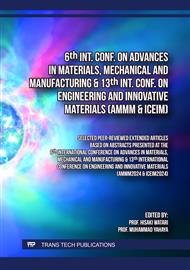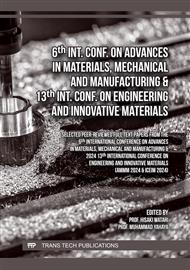[1]
M. S. Saad, A. Mohd Nor, M. Z. Zakaria, M. E. Baharudin, and W. S. Yusoff, "Modelling and evolutionary computation optimization on FDM process for flexural strength using integrated approach RSM and PSO," Progress in Additive Manufacturing, vol. 6, no. 1, p.143–154, Feb. 2021.
DOI: 10.1007/s40964-020-00157-z
Google Scholar
[2]
J. Y. Lee, J. An, and C. K. Chua, "Fundamentals and applications of 3D printing for novel materials," Jun. 01, 2017, Elsevier Ltd.
DOI: 10.1016/j.apmt.2017.02.004
Google Scholar
[3]
M. K. Pitchan, S. Bhowmik, M. Balachandran, and M. Abraham, "Process optimization of functionalized MWCNT/polyetherimide nanocomposites for aerospace application," Mater Des, vol. 127, p.193–203, Aug. 2017.
DOI: 10.1016/j.matdes.2017.04.081
Google Scholar
[4]
I. Blanco, G. Cicala, G. Ognibene, M. Rapisarda, and A. Recca, "Thermal properties of polyetherimide/polycarbonate blends for advanced applications," Polym Degrad Stab, vol. 154, p.234–238, Aug. 2018.
DOI: 10.1016/j.polymdegradstab.2018.06.011
Google Scholar
[5]
G. Nyiranzeyimana, J. M. Mutua, B. R. Mose, and T. O. Mbuya, "Optimization of process parameters in fused deposition modelling of thermoplastics: A review," Materwiss Werksttech, vol. 52, no. 6, p.682–694, Jun. 2021.
DOI: 10.1002/mawe.202000193
Google Scholar
[6]
A. Lustiger, F. S. Uralil, and G. M. Newaz, "Processing and Structural Optimization of PEEK Composites."
Google Scholar
[7]
M. F. Arif, S. Kumar, K. M. Varadarajan, and W. J. Cantwell, "Performance of biocompatible PEEK processed by fused deposition additive manufacturing," Mater Des, vol. 146, p.249–259, May 2018.
DOI: 10.1016/j.matdes.2018.03.015
Google Scholar
[8]
N. Vidakis, M. Petousis, N. Mountakis, and E. Karapidakis, "Box-Behnken modeling to quantify the impact of control parameters on the energy and tensile efficiency of PEEK in MEX 3D-printing," Heliyon, vol. 9, no. 7, Jul. 2023.
DOI: 10.1016/j.heliyon.2023.e18363
Google Scholar
[9]
K. Park, G. Kim, H. No, H. W. Jeon, and G. E. O. Kremer, "Identification of optimal process parameter settings based on manufacturing performance for fused filament fabrication of CFR-PEEK," Applied Sciences (Switzerland), vol. 10, no. 13, Jul. 2020.
DOI: 10.3390/app10134630
Google Scholar
[10]
R. B. Kristiawan, F. Imaduddin, D. Ariawan, Ubaidillah, and Z. Arifin, "A review on the fused deposition modeling (FDM) 3D printing: Filament processing, materials, and printing parameters," Jan. 01, 2021, De Gruyter Open Ltd.
DOI: 10.1515/eng-2021-0063
Google Scholar
[11]
A. Pandzic, D. Hodzic, and A. Milovanovic, "Effect of infill type and density on tensile properties of pla material for fdm process," in Annals of DAAAM and Proceedings of the International DAAAM Symposium, Danube Adria Association for Automation and Manufacturing, DAAAM, 2019, p.545–554.
DOI: 10.2507/30th.daaam.proceedings.074
Google Scholar
[12]
A. Forés-Garriga, M. A. Pérez, G. Gómez-Gras, and G. Reyes-Pozo, "Role of infill parameters on the mechanical performance and weight reduction of PEI Ultem processed by FFF," Mater Des, vol. 193, Aug. 2020.
DOI: 10.1016/j.matdes.2020.108810
Google Scholar
[13]
C. C. Santiago et al., "Thermoplastic extrusion additive manufacturing of high-performance carbon fiber peek lattices," Crystals (Basel), vol. 11, no. 12, Dec. 2021.
DOI: 10.3390/cryst11121453
Google Scholar
[14]
X. Deng, Z. Zeng, B. Peng, S. Yan, and W. Ke, "Mechanical properties optimization of poly-ether-ether-ketone via fused deposition modeling," Materials, vol. 11, no. 2, Jan. 2018.
DOI: 10.3390/ma11020216
Google Scholar
[15]
Y. Wang, W. D. Müller, A. Rumjahn, F. Schmidt, and A. D. Schwitalla, "Mechanical properties of fused filament fabricated PEEK for biomedical applications depending on additive manufacturing parameters," J Mech Behav Biomed Mater, vol. 115, Mar. 2021.
DOI: 10.1016/j.jmbbm.2020.104250
Google Scholar
[16]
M. S. Saad, A. M. Nor, M. E. Baharudin, M. Z. Zakaria, and A. F. Aiman, "Optimization of surface roughness in FDM 3D printer using response surface methodology, particle swarm optimization, and symbiotic organism search algorithms," International Journal of Advanced Manufacturing Technology, vol. 105, no. 12, p.5121–5137, Dec. 2019.
DOI: 10.1007/s00170-019-04568-3
Google Scholar
[17]
D. Yadav, D. Chhabra, R. Kumar Garg, A. Ahlawat, and A. Phogat, "Optimization of FDM 3D printing process parameters for multi-material using artificial neural network," in Materials Today: Proceedings, Elsevier Ltd, 2020, p.1583–1591.
DOI: 10.1016/j.matpr.2019.11.225
Google Scholar
[18]
J. Borah and M. Chandrasekaran, "Experimental investigation and development of Artificial neural network modeling of 3D printed PEEK bio implants and its optimization," 2023.
DOI: 10.21203/rs.3.rs-3204960/v1
Google Scholar
[19]
S. R. Rajpurohit and H. K. Dave, "Prediction and Optimization of Tensile Strength in FDM Based 3D Printing Using ANFIS," 2020, p.111–128.
DOI: 10.1007/978-3-030-19638-7_5
Google Scholar
[20]
A. Peng, X. Xiao, and R. Yue, "Process parameter optimization for fused deposition modeling using response surface methodology combined with fuzzy inference system," International Journal of Advanced Manufacturing Technology, vol. 73, no. 1–4, p.87–100, 2014.
DOI: 10.1007/s00170-014-5796-5
Google Scholar
[21]
M. Srivastava, S. Rathee, S. Maheshwari, and T. K. Kundra, "Multi-objective optimisation of fused deposition modelling process parameters using RSM and fuzzy logic for build time and support material," International Journal of Rapid Manufacturing, vol. 7, no. 1, p.25, 2018.
DOI: 10.1504/ijrapidm.2018.089727
Google Scholar
[22]
B. Vinay et al., "Influence of Printing Parameters on Mechanical Behavior of 3D-Printed PLA Using Taguchi Based ANFIS Technique," Materials Science Forum, vol. 1110, p.159–174, Jul. 2023.
DOI: 10.4028/p-LsQr5J
Google Scholar
[23]
"Standard Test Method for Tensile Properties of Plastics 1".
DOI: 10.1520/D0638-14
Google Scholar
[24]
V. D. Sagias, P. Zacharia, A. Tempeloudis, and C. Stergiou, "Mechanical Properties Predictive Model of Additive Manufacturing Specimens Using ANFIS," 2024.
DOI: 10.20944/preprints202407.0094.v1
Google Scholar



